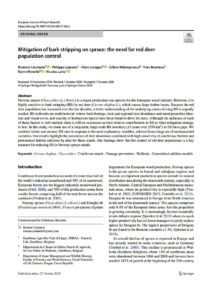
Candaele R., Lejeune P., Licoppe A., Malengreaux C., Brostaux Y., Morelle K., Latte N.
doi.org/10.1007/s10342-020-01326-z
Norway spruce (Picea abies (L.) Karst.) is a major production tree species for the European wood industry. However, it is highly sensitive to bark stripping (BS) by red deer (Cervus elaphus L.), which causes large timber losses. Because the red deer population has increased over the last decades, a better understanding of the underlying causes driving BS is urgently needed. BS outbreaks are multifactorial: winter food shortage, local and regional deer abundance and stand properties (thermal and visual cover, and scarcity of herbaceous layers) have been found to drive BS rates. Although the influence of each of these factors is well studied, there is still no consensus on their relative contributions to BS or what mitigation strategy is best. In this study, we made use of a long-term, large-scale BS inventory (13 years over 2570 km2) to fill these gaps. We modeled winter and summer BS rates in response to the most explanatory variables, selected from a large set of environmental variables. Our results highlight the prevalence of deer abundance combined with high sensitivity of coniferous thickets and pronounced habitat selection by deer for these stands. Our findings show that the control of red deer populations is a key measure for reducing BS in Norway spruce stands.
Consultez la notice complète de l’article sur ORBi
